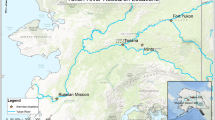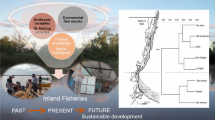Abstract
The urgency of managing marine resources is based on the fact that half of the world stocks are fully exploited, excluding those stocks that are already depleted. Artisanal fisheries in Brazil, both inland and coastal, are responsible for about half of the country’s catches. Therefore, management of local artisanal fisheries is a necessity that provides an additional benefit, considering the observation that decentralization and the use of local ecological knowledge (LEK) in management have given better results than centralized, top-down management. In this study, a third system of knowledge–based on practice and training–is built from the local and scientific systems of knowledge, and a method to accomplish practical steps in local management is shown. Four elements are considered for the process of linking systems towards management: (1) an understanding of the natural environment of the fishery and on the use of natural resources by locals; (2) the knowledge of the marine area used by fishers, i.e., location of fishing spots for each species; (3) the understanding of fisher behavior, e.g., using tools from optimal foraging theory; and (4) the knowledge fishers have of the biology and ecology of species and their LEK, based on studies of the ethnobiology, ethnoecology, and ethnotaxonomy of fish. Considering the availability of publications on topics 1 and 2, illustrative cases are shown using optimal foraging models in Itaipu Beach, Rio de Janeiro and São Paulo Bagre, Cananéia, São Paulo, and using common snook, Centropomus undecimalis, as an example for a target species. Finally, local programs including training courses using both scientific and local knowledge are proposed within coastal artisanal fisheries.




Similar content being viewed by others
References
Aliaume, C., Zerbi, A., Joyeux, J. C., & Miller, J. M. (2000). Growth of juvenile Centropomus undecimalis in a tropical island. Environmental Biology of Fishes, 59, 299–308.
Bailey, P. B., & Petrere Jr. M. (1989). Amazon fisheries: Assessment methods, current status and management options. Canadian Special Pub. in Fisheries and Aquatic Sciences, 106, 385–398.
Begossi, A. (1992). The use of optimal foraging theory in the understanding of fishing strategies: A case from Sepetiba Bay (Rio de Janeiro state, Brasil). Human Ecology, 20(4), 463–475.
Begossi, A. (2001a). Mapping spots: Fishing areas and territories in the Atlantic Forest coast, Brazil. Regional Environmental Change, 2, 1–12.
Begossi, A. (2001b). Cooperative and territorial resources: Brazilian artisanal fisheries. In J. Burger, R. Norgaard, E. Ostrom, D. Policansky, & B. Goldstein (Eds.), The commons revisited: An Americas perspective (pp. 109–130). Washington DC: Island Press.
Begossi, A. (2006). Temporal stability in fishing spots: Conservation and co-management in Brazilian artisanal coastal fisheries, Ecology & Society, 11(1), 5 (http://www.ecologyandsociety.org/vol11/iss1).
Begossi, A., & Brown, D. (2003). Fisheries co-management experiences in Latin America, the Caribbean. In D. C. Wilson, J. R. Nielsen, & P. Degnbol (Eds.), The fisheries co-management experience (pp. 135–152). Dordrecht: Kluwer Academic Pub.
Begossi, A., Clauzet, M., Castro, F., Hanazaki, N., MacCord, P. F., Ramires, M., & Silvano, R. A. M. (2006, October). The foraging behavior of riverine and coastal fishers from the Amazon and the Atlantic Forest coast. Paper presented at the XIV International Meeting of the Society for Human Ecology, Bar Harbor, Maine, unpublished.
Begossi, A., & Garuana, L. (2006). O conhecimento dos peixes no Posto 6, Copacabana, Rio de Janeiro. São Paulo: Folder FIFO/UNICAMP.
Begossi, A., Hanazaki, N., & Peroni N. (2000). Knowledge and use of biodiversity in Brazilian hot spots. Environment, Development and Sustainability, 2(3–4), 177–193.
Begossi, A., Hanazaki, N., & Ramos, R. M. (2004a). Food chain and the reasons for food taboos in the Amazon and in the Atlantic Forest coast. Ecological Applications, 14(5), 1334–1343.
Begossi, A, Hanazaki, N., & Tamashiro, J. Y. (2002). Medicinal plants in the Atlantic Forest (Brazil): Knowledge, use, and conservation. Human Ecology, 30(3), 281–299.
Begossi, A., Silva, A. L., Hanazaki, N., Peroni, N., Pezzuti, J., & Silvano, R. A. M. (2004b). Ecologia de Pescadores da Mata Atlântica e Amazônia. São Paulo: Ed. Hucitec.
Berkes, F. (1999). Sacred ecology. Philadelphia: Taylor & Francis.
Berkes, F., Mahon, R., McConney, P., Pollnac, R. e Pomeroy, R. (2001). Managing small-scale fisheries. Canadá: IDRC-CRDI (booktíque, http://www.idrc.ca).
Carvalho-Filho, A. (1994). Peixes da Costa Brasileira. SP: SABESP.
Cordell, J. (1989). A sea of small boats. Cambridge: Cultural Survival.
Cordell, J. (2006). Scaling up marine management, the role of marine protected areas. Washington DC: The World Bank.
Davy, B. (2000). Foreword. In F. Berkes, R. Mahon, P. McConney, R. Pollnac, & R. Pomeroy (Eds.), Managing small-scale fisheries. Canadá: IDRC-CRDI (booktíque, http://www.idrc.ca).
Diegues, A. C. (1983). Pescadores, camponeses e trabalhadores do mar. São Paulo: Ed. Ática.
FAO (2005). Review of the world marine fishery resources. FAO Technical Paper 47 (http://www.fao.org).
Forman, S. (1967). Cognition and the catch: The location of fishing spots in a Brazilian coastal village. Ethnology, 6, 417–426.
Froese, R., & Pauly, D. (2006). Fishbase (http://www.fishbase.org).
Hanazaki, N. (2001). Ecologia de caiçaras: uso de recursos e dieta. Dissertation, UNICAMP.
Hara, M., & e Nielsen, J. R. (2003). Experiences with fisheries management in África. In D. C. Wilson, J. R. Nielsen, & P. Degnbol (Eds.), The Fisheries co-management experience (pp. 81–98). Dordrecht: Kluwer Academic Pub.
Harris, M. (1976). History and significance of the Emic/Etic distinction. Annual Review of Anthropology, 5, 329–340.
Hauck, M., & e Sowman, M. (2003) Waves of change: Coastal and fisheries co-management in South Africa. Landsowne: The University of Cape Town Press.
Hauck, M., & Sowman, M. (2005). Guidelines for implementing coastal and fisheries co- management in South Africa. Subsistence fishing co-management and capacity building programmme. Cape Town: University of Cape Town, University of Western Cape & Dept. of Environmental Affairs and Tourism, South Africa.
Johannes, R. E. (1981). Words of the lagoon. Berkeley: University of California Press.
Johannes, R. E. (2000). Ignore fisher’s knowledge and miss the boat. Fish and Fisheries, 1, 257–271.
Lowerre-Barbieri, S. K., & Whittington, J. A. (2003). Catch-and-release fishing on a spawning aggregation of common snook: Does it affect reproductive output? Transactions of the American Fisheries Society, 132, 940–952.
MacCord, P. F., & Begossi, A. (2006). Dietary changes over time in a Caiçara community from the Brazilian Atlantic Forest. Ecology & Society, 11(2), 38 (http://www.ecologyandsociety.org/vol11/iss12/art38).
Nehrer, R., & Begossi, A. (2000). Fishing at Copacabana, Rio de Janeiro: Local strategies in a global city. Ciência e Cultura, 52(1), 26–30.
Orians, G. H., & Pearson, E. (1979). On the theory of central place foraging, Analysis of Ecological Systems. In D. J. Honrs, G. R. Stairs, & R. D (Eds.), Columbus: Mitchell, Ohio State University.
Peters, K. M., Matheson, R. E., & Taylor, R. G. (1998). Reproduction and early life history of common snook, Centropomus undecimalis (Bloch) in Florida. Bulletin of Marine Science, 62, 509–529.
Pinnegar, J. K., & Engelhard, G. H. (2007). The ‘shifting baseline’ phenomena: A global perspective. Reviews in Fish Biology and Fisheries. doi: 10.1007/s11160-007-9058-6.
Pyke, G. H. (1984). Optimal foraging theory: A critical review. Annual Review of Ecology and Systematics, 15, 523–575.
Ruddle, K. (1998). Traditional community based coastal marine fisheries management in Vietnam. Ocean and Coastal Management, 40, 1–22.
Ruddle, K. (2000). Systems of knowledge: Dialogue, relationships and process, Environment. Development and Sustainability, 2, 277–304.
Silvano, R. A. M. (2004). Pesca artesanal e etnoictiologia. In A. Begossi, Org (Ed.), Ecologia de Pescadores da Mata Atlântica e Amazônia. São Paulo: Ed. Hucitec.
Silvano R. A. M., & Begossi, A. (2005). Local knowledge on a cosmopolitan fish. Ethnoecology of Pomatomus saltatrix (Pomatomidae) in Brazil and Australia. Fisheries Research, 71, 43–59.
Silvano, R. A. M., Mac Cord, P., & Lima, R. V., e Begossi, A. (2006). When does this fish spawn? Fishermen’s local knowledge of migration and reproduction of Brazilian coastal fishes. Environmental Biology of Fishes, 76, 371–386.
Silvano, R. A. M., Silva, A. L., Ceroni, M., & e Begossi, A. (2007). Contributions of Ethnobiology to the conservation of tropical rivers and streams. Aquatic Conservation: Marine and Freshwater Ecosystems (in press). doi:10.1002/aqc.825
Souza-Filho, J. J., & Cerqueira, V. R. (2003). Influência da densidade de estocagem no cultivo de juvenis de robalo-flecha mantidos em laboratório. Pesquisa Agropecuária Brasileira, 38, 1317–1322.
Stephens, D. W., & Krebs, J. R. (1986). Foraging theory. New Jersey: Princeton University Press.
Taylor, R. G., Grier, H. J., & Whittington, J. A. (1998). Spawning rhythms of common snook in Florida. Journal of Fish Biology, 53, 502–520.
Taylor, R. G., Whittington, J. A., Grier, H. J., & Crabtree, R. E. (2000). Age, growth, maturation, and protandric sex reversal in common snook, Centropomus undecimalis, from the east and west coasts of South Florida. Fisheries Bulletin, 98, 612–624.
Taylor, R. G., Whittington, J. A., & Haymans, D. E. (2001). Catch-and-release mortality of common snook in Florida. North American Journal of Fishery Management, 21, 70–75.
Tilghman, R. W., Ross, C. I., Mari, F., & Hartmann, J. X. (1996). Paralbumins as biomarker for fish species identification, IEEE. doi:0-7803-3519-8/96
Valbo-Jorgensen, J., & Poulsen, A. F. (2000). Using local knowledge as a research tool in the study of river fish biology: Experiences from the Mekong. Environment, Development and Sustainability, 2, 253–276.
Wilson, D. C., Nielsen, J. R., & Degnbol P. (Eds.) (2003). The fisheries co-management experience. Dordrecht: Kluwer Academic Pub.
Acknowledgements
I am grateful to E. Camargo for help in marking fishing spots at Bertioga and Guarujá, São Paulo; to FAPESP grants: 06/50435-0 and 06/59743-9). Key suggestions were given by R. A. M. Silvano and P. L. MacCord. Salvador Carpi Jr. drew the spot map.
Author information
Authors and Affiliations
Corresponding author
Additional information
Readers should send their comments on this paper to: BhaskarNath@aol.com within 3 months of publication of this issue.
Rights and permissions
About this article
Cite this article
Begossi, A. Local knowledge and training towards management. Environ Dev Sustain 10, 591–603 (2008). https://doi.org/10.1007/s10668-008-9150-7
Received:
Accepted:
Published:
Issue Date:
DOI: https://doi.org/10.1007/s10668-008-9150-7




